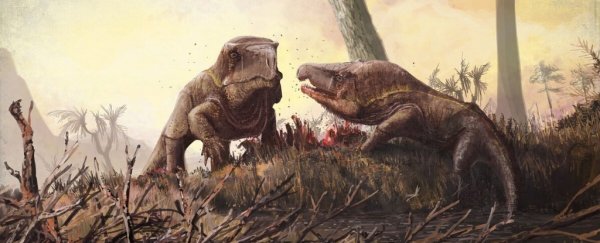Surviving the worst mass extinction event in the planet's history is bound to give you a big head. But even in the Early Triassic, when large skulls were unexceptional, one predator carried around a bigger noggin than most.
At the close of the Permo-Triassic extinction, millions of years before dinosaurs arrived on the scene, a family of large "red crocodiles', otherwise known as Erythrosuchids, roamed the planet on all fours.
Growing three to five metres (10 to 16 feet) in length, these terrestrial lizards were apex predators, and their powerful yet short bodies were dominated by one intimidating feature: their sizeable skulls.
A closer look at the most completely known erythrosuchid fossil, found in Russia, has now revealed just how remarkable those craniums were.
Relative to its overall body size, researchers conclude this prehistoric lizard had one of the largest heads of any reptile and the biggest head of any known dinosaur.
"We don't know for sure why this was the case, but we hypothesise that it might have been linked to their role as the top predators in a number of Triassic ecosystems," Richard Butler, a palaeobiologist from the University of Birmingham, told Newsweek, "having a big, powerful head and bite is likely to be useful in capturing prey."
The oldest genus of erythrosuchid is a Garjainia, with examples found in Russia - Vjushkovia triplicostata - and in South Africa - Garjainia prima. These creatures are thought to be terrestrial hypercarnivores, which means their diet contains more than 70 percent meat, like today's crocodiles.
But there's still a lot we don't know about these fiersome predators. While Garjainia remains found in Russia include a nearly complete skull, this set of seven skeletons has remained relatively unstudied compared to its southern brethren, G. prima.
Now, the first full anatomical description of V. triplicostata suggests these two separate creatures were not so different after all. In fact, it turns out, they were actually the same species.
Not only are their heads similarly massive, taking up roughly a quarter of their entire body length, researchers report both specimens are almost identical in form, with remarkably few differences to speak of.
V. triplicostata, for instance, had a small number of palatal teeth, whereas G. prima did not. But while this might seem like a big discrepancy, teeth are not easily preserved through the years, and even if they did make it, they can be hard to find on a fossilised skull.
Besides, the authors argue, this sort of variation is to be expected within species.
The authors believe this variation could also be explained in part by differences in how the fossils were preserved but agree with previous authors who consider them as one species.
No matter whether they lived, whether in Russia or in South Africa, Garjainia lizards kept their unusually large heads balanced atop their burly frames.
Comparing their skull and femurs to 89 currently living mammals, lepidosaurs and crocodilians, as well as 41 fossilised dinosaurs and pterosaurs from the Early Triassic, the authors found no other proportions quite like it.
Their heads were disproportionately large compared to other crocodiles, dinosaurs and birds. And while this may seem like a hindrance, larger heads tend to be associated with carnivorous animals.
"These are bizarre animals, but much about their biology remains unstudied," Butler told Newsweek.
"They presumably must have had very powerful neck muscles to support such a massive head, but detailed studies of their muscles have not yet been done."
Let's hope for the lizard's sake their muscles were extra sturdy.
The study was published in Royal Society Open Science.
